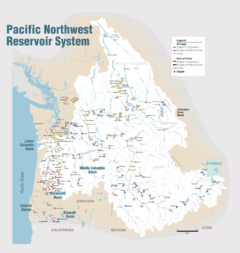| Hells Canyon Dam | |
|---|---|
 Aerial view from northeast | |
Location in Idaho | |
| Country | United States |
| Location | Hells Canyon, Adams County, Idaho / Wallowa County, Oregon |
| Coordinates | 45°14′41″N 116°41′54″W / 45.24472°N 116.69833°W |
| Opening date | 1967 |
| Operator(s) | Idaho Power Company |
| Dam and spillways | |
| Impounds | Snake River |
| Height | 330 ft (100 m) |
| Reservoir | |
| Creates | Hells Canyon Reservoir |
| Total capacity | 188,000 acre⋅ft (232,000,000 m3) |
| Catchment area | 73,300 sq mi (189,800 km2) |
| Surface area | 3.9 sq mi (10 km2) |
| Normal elevation | 1,650 ft (503 m) |
| Power Station | |
| Installed capacity | 391 MW |
| Annual generation | 2,051.3 GWh |
 | |
Hells Canyon Dam is a concrete gravity dam in the western United States, on the Snake River in Hells Canyon along the Idaho-Oregon border. At river mile 247, the dam impounds Hells Canyon Reservoir; its spillway elevation is 1,680 feet (512 m) above sea level.
It is the third and final hydroelectric dam of the Hells Canyon Project, which includes Brownlee Dam (1959) and Oxbow Dam (1961), all built and operated by Idaho Power Company. The Hells Canyon Complex on the Snake River is the largest privately owned hydroelectric power complex in the nation, according to the US Energy Information Administration.[1] The contractor for the Hells Canyon Dam was Morrison-Knudsen of Boise.
The Hells Canyon Dam powerhouse contains three generating units, with a total nameplate capacity of 391 megawatts (MW).[2] Power generation began with two units in 1967, the third came on line the following year.
Lacking passage for migrating salmon, the three dams of the Hells Canyon Project blocked access by anadromous salmonids to a stretch of the Snake River drainage basin from Hells Canyon Dam up to Shoshone Falls, which naturally prevents any upstream fish passage to the upper Snake River basin.
- ^ "State Energy Profiles: Idaho". U.S. Department of Energy. December 23, 2010. Archived from the original on November 17, 2010. Retrieved December 27, 2010.
- ^ "Hells Canyon Dam – General Information". Columbia Basin Research, University of Washington. Retrieved December 27, 2010.

